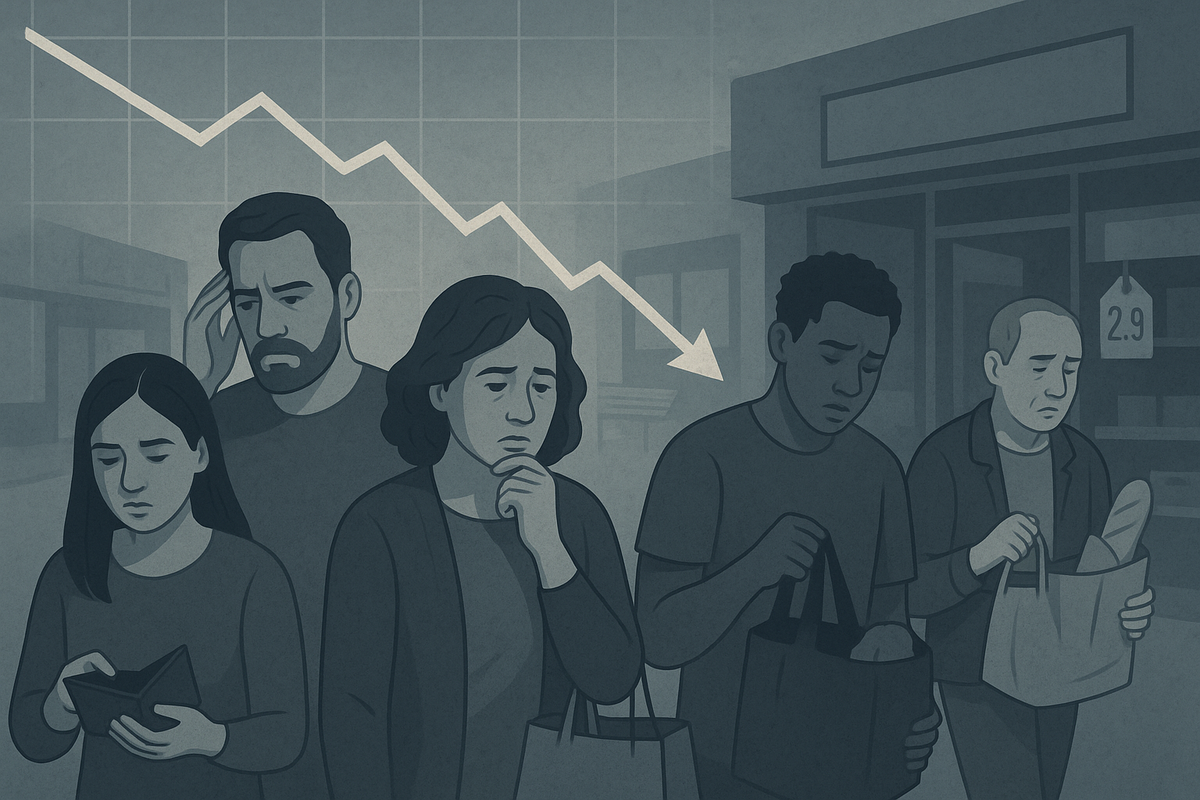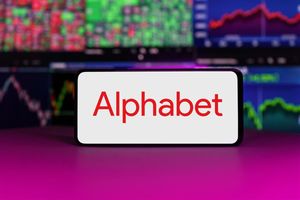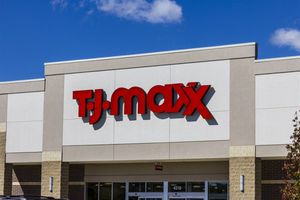
The United States is currently grappling with a significant decline in consumer sentiment, a trend primarily fueled by escalating inflation concerns and increasingly unfavorable buying conditions. This downturn is manifesting in a noticeable slowdown in consumer spending, with lower-income households bearing the brunt of the economic squeeze. As the crucial back-to-school shopping season unfolds, retailers and economists are closely watching for further indications of a cautious consumer, signaling potential headwinds for the broader economy.
This erosion of confidence suggests that American households are becoming more apprehensive about their financial futures, leading to a more conservative approach to spending. The implications are far-reaching, impacting everything from retail sales to the overall trajectory of economic growth.
A Deep Dive into Dwindling Confidence
The recent decline in U.S. consumer sentiment is a multifaceted issue, with several key factors contributing to its current state. Data from various sources paints a consistent picture of a consumer base under pressure. The University of Michigan's consumer sentiment index, a closely watched barometer of economic mood, registered a notable 5% drop in August 2025, marking its first decline in four months. This dip was particularly pronounced among middle-income earners, highlighting a broad-based erosion of confidence. Earlier in 2025, the index had already touched a seven-month low in February, underscoring a persistent downward trend throughout the year.
Similarly, The Conference Board Consumer Confidence Index, while showing some fluctuations, has also reflected underlying anxieties. After a period of declines linked to tariff concerns, the index saw a modest increase in July and August 2025. However, it had previously sunk to its lowest reading since May 2020 in April 2025, largely due to the same tariff-related worries. These indices collectively indicate a consumer landscape characterized by uncertainty and a growing sense of economic vulnerability.
The primary drivers behind this slump are clear: persistent inflation and less favorable buying conditions. Year-ahead inflation expectations have steadily climbed, reaching 4.9% in August 2025, up from 4.5% in July. Long-run expectations have also risen, signaling a belief among consumers that higher prices are here to stay. Inflation, alongside tariff policies, has consistently been cited as a top concern for U.S. consumers throughout 2025, with a significant portion of the population identifying rising prices as their primary worry. This inflationary pressure directly translates into less favorable buying conditions. In August 2025, buying conditions for durable goods plummeted by 14%, reaching a one-year low due to elevated costs. Consumers are responding by actively seeking sales, comparing prices, utilizing coupons, and even reusing items, particularly for back-to-school purchases. The anticipation and implementation of tariffs have further exacerbated these concerns, leading many to adjust their spending habits proactively.
The Shifting Sands of Spending: Winners and Losers
The current economic climate, marked by declining consumer sentiment and slowing spending, is creating a distinct landscape of winners and losers across various industries. Companies that cater to value-conscious consumers and offer essential goods are likely to fare better, while those reliant on discretionary spending, particularly for big-ticket items, may face significant challenges.
Retailers with strong discount offerings and private-label brands are poised to benefit. Companies like Walmart (NYSE: WMT) and Target (NYSE: TGT), known for their competitive pricing and broad product assortments, are likely to see increased foot traffic and sales as consumers prioritize affordability. Similarly, dollar stores such as Dollar General (NYSE: DG) and Dollar Tree (NASDAQ: DLTR) could experience a surge in demand as lower-income households stretch their budgets further. These retailers are well-positioned to capture market share from higher-priced competitors as consumers trade down.
Conversely, companies in the durable goods sector, such as automotive manufacturers like General Motors (NYSE: GM) and Ford (NYSE: F), and home appliance retailers like Best Buy (NYSE: BBY), are likely to face headwinds. The significant decline in buying conditions for durable goods, coupled with rising interest rates, will likely deter consumers from making large purchases. Luxury brands and high-end retailers may also see a slowdown in sales as even higher-income households become more cautious with their discretionary spending. Furthermore, companies heavily reliant on imported goods, particularly those affected by increased tariffs, could see their profit margins squeezed, potentially leading to higher prices for consumers or reduced profitability.
The back-to-school season, a critical period for many retailers, will serve as a litmus test. While overall spending is expected to remain flat, companies offering essential school supplies and affordable apparel will likely outperform those selling non-essential or higher-priced items. Technology companies, such as Apple (NASDAQ: AAPL) or Microsoft (NASDAQ: MSFT) (through its Surface products), might still see some demand for essential educational devices, but even here, consumers are expected to be more price-sensitive, opting for more budget-friendly options.
Industry Impact and Broader Implications
The decline in U.S. consumer sentiment and the subsequent slowdown in spending are not isolated events; they are deeply intertwined with broader industry trends and carry significant implications for the wider economy. This shift signals a potential deceleration in economic growth, as consumer spending accounts for a substantial portion of the nation's GDP.
The retail sector, in particular, is on the front lines of this economic shift. Companies that have not adapted to the increasing demand for value and affordability may struggle to maintain market share. This trend could accelerate the ongoing transformation of the retail landscape, favoring e-commerce platforms and discount retailers over traditional brick-and-mortar stores with higher overheads. The emphasis on price comparison and coupon usage suggests a more informed and strategic consumer, forcing retailers to innovate their pricing and promotional strategies.
Beyond retail, the ripple effects extend to manufacturing, logistics, and even the financial sector. A slowdown in durable goods purchases, for instance, directly impacts manufacturing output and employment in those industries. Increased delinquency rates on credit cards and auto loans, particularly among lower-income households, could signal rising financial stress and potentially lead to a tightening of lending standards by financial institutions. This, in turn, could further dampen consumer spending and investment.
Historically, periods of declining consumer sentiment and rising inflation have often preceded economic slowdowns or recessions. While the current situation may not be as severe as past crises, the parallels are concerning. The disproportionate impact on lower-income households also raises questions about income inequality and social stability. As federal program cuts take effect and tariffs continue to push up prices, the gap between income levels is expected to widen, potentially exacerbating social and economic disparities. Regulatory bodies and policymakers will be closely monitoring these trends, and there may be calls for interventions to support vulnerable households and stimulate economic activity.
What Comes Next
The immediate future will likely see a continued period of cautious consumer behavior. In the short term, retailers will be intensely focused on their holiday season strategies, attempting to entice wary shoppers with aggressive promotions and value-driven offerings. Companies that can effectively manage their supply chains to mitigate the impact of tariffs and offer competitive pricing will be better positioned. We may also see an acceleration of trends like "buy now, pay later" options as consumers seek to spread out their expenses.
In the long term, businesses may need to undertake significant strategic pivots. This could involve re-evaluating product portfolios to focus on essential goods, investing in more efficient production methods to control costs, and exploring new markets or distribution channels. The emphasis on value and price sensitivity is unlikely to dissipate quickly, meaning companies will need to build these considerations into their core business models. For example, companies like Procter & Gamble (NYSE: PG) and Unilever (NYSE: UL), which offer a wide range of consumer staples, might see sustained demand for their more affordable brands.
Market opportunities may emerge for companies that can innovate in areas like sustainable and cost-effective alternatives, or those that offer services that help consumers save money. Conversely, challenges will persist for industries heavily reliant on discretionary spending or those with high exposure to tariff-affected imports. Potential scenarios range from a gradual recovery in consumer confidence as inflation moderates, to a more prolonged period of subdued spending if economic uncertainties persist. Investors should closely watch inflation data, employment figures, and retail sales reports for signs of either improvement or further deterioration.
A Cautious Outlook for the American Consumer
In conclusion, the recent decline in U.S. consumer sentiment is a critical indicator of underlying economic anxieties, primarily driven by persistent inflation and less favorable buying conditions. The slowdown in consumer spending, particularly among lower-income households, underscores the widespread impact of these pressures. The back-to-school season serves as a crucial barometer, revealing a consumer base that is increasingly cost-conscious and strategic in its purchasing decisions.
Moving forward, the market will be characterized by a heightened focus on value and affordability. Companies that can adapt to this new reality by offering competitive pricing, essential goods, and efficient supply chains will be better positioned to navigate the challenging economic landscape. Investors should pay close attention to inflation trends, consumer confidence indices, and retail sales data, as these will provide key insights into the trajectory of the American consumer and the broader economy in the coming months. The lasting impact of this period of caution could reshape consumer behavior and industry strategies for years to come, emphasizing resilience and adaptability in an uncertain economic environment.






